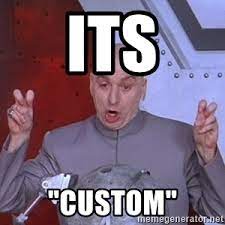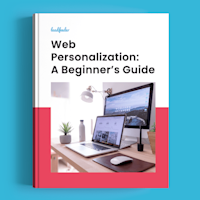Higher ed has a major problem.
According to the 2020 survey of admission leaders, a record number of college and university leaders reported feeling "very concerned" about filling their classes.
The same survey reported 74 percent of leaders in public master's/bachelor's institutions expect enrollment for 2020 to be the same or lower than it was in 2019.
It's not just COVID, either. Admission rates have been stagnant or falling for the past several years.
There's no easy answer to combatting falling admission rates, but there is one marketing strategy that many admission leaders are overlooking — website personalization.
Note: Want to see what companies visit your website? We can help. Leadfeeder shows you exactly what other companies do on your website so you can create more effective sales and marketing strategies.
What Is Website personalization?
Website personalization is a marketing strategy that uses behavioral data collected about site visitors to create a customized website experience.

You've likely seen it in action, maybe without realizing it. For example, "People also bought" recommendations on Amazon or the "You might also like…" recommendation on streaming services like Netflix are simplified versions of website personalization.
However, personalization efforts can go a lot deeper.
Say you fill out a form to sign up for a webinar, but get distracted and close the tab before completing it. Later, you go back to the same site, and — like magic — your information is still saved in the form.
That's website personalization at work.
Website personalization can also be used to suggest relevant content, show different pictures to different types of visitors, or deliver custom landing pages to different customer segments.
Many tools also use website personalization, including Leadfeeder's Discover feature, which uses firmographic filters to provide visitors with a personalized experience based on location and the company they work for.
Why higher education should use website personalization
Most higher education sites reach a wide range of audiences — different types of students, different locations, even different programs. That can make segmenting audiences difficult.
Here are a few reasons why higher education sites should be considering website personalization as part of their marketing strategy.
More competition
The popularization of online learning has increased competition in higher education. In the past, most institutions only had to compete with schools in their general geographical area or those with similar programs. Students today have more options than ever before — which makes targeting students effectively more important than ever.
Students expect personalization
Brands like Amazon and Netflix have created a generation of people who expect a personalized experience. Students today expect the businesses (and schools) they interact with to understand who they are and what they want. In fact, 72 percent of consumers will only engage with marketing messages customized to meet their specific interests.
This means if higher education websites don't offer the personalized experience students have come to expect, they're losing out.
College websites are key to decision making
College websites are key sources of information students rely on when deciding which school to attend. Especially when on-campus visits are limited, students expect to find all the information they need on your website. Failing to deliver can put higher education institutions at a severe disadvantage.
4 Ways to Leverage Website Personalization for Higher Education
Website personalization goes beyond recommending products and shows to watch. Higher education can benefit from this strategy as well. Charles Sturt University increased applications by 127 percent and lowered their cost per acquisition by 32 percent by using website personalization for prospective students.

Here are a few ways higher education institutions can leverage this marketing strategy to increase applications and enrollment while lowering their cost per acquisition.
Customize based on location
With website personalization, your school can deliver custom content, videos, and contact pages based on the student's location. Let's say your visitor is from Florida. You can promote events close to their current location or provide information on your Florida campus, while a visitor from Maryland could see events and programs near them.
Schools with multiple campuses could also promote programs located at the closest campus location or suggest a global program for students who are hundreds of miles from any campus.
Adjust based on student type
Different types of students have different needs — and different concerns. For example, a military student might be interested in information about funding or online courses, while a recent high-school graduate might be more interested in the cost of dorms or social clubs.
On the other hand, a returning student may be concerned about how many of their credits will transfer or whether your school offers on-site childcare.
Website personalization allows your site to suggest content, events, support, and even reviews that most closely match the marketing experience students are looking for.
Adjust based on program interest
No one wants to spend several minutes searching for the type of content they need. In fact, most site users will spend 15 seconds or less looking for the information before heading back to the search results.
With website personalization, however, you can deliver information on specific or related programs. For example, a visitor looking at medical degrees can be directed to medical programs, while a student interested in studio art can be directed to Art History and MFA programs.
Website personalization extends beyond directing users to specific content — sites can also update hero images, suggest profiles from students in those programs, or create customized landing pages that address challenges specific students might face.
Recognize previous site visitors
Nearly everyone who visits your website is a prospective (or current) student. Understanding who has visited your site before allows you to create a customized experience that can lower the cost per acquisition and provide visitors with precisely the information they need.
For example, you can direct current students to log in to your student portal, while prospective students are directed to a program they already looked at or prompted to finish completing an application.
Web personalization and higher ed are a perfect match
Website personalization allows higher education institutions to deliver relevant experiences that prospective students expect.
Rather than relying on the same content to convert prospective students into current students, schools can deliver hyper-relevant content, images, and videos. This presents a whole new world of opportunity for higher education institutions.
Account-Based Marketing. Simplified.
Struggling to connect the dots between your ABM campaigns and revenue? Or maybe just trying to launch your first ABM program? It doesn’t have to be that difficult.
Identify new accounts, know when target accounts visit your site, and enrich advertising campaigns with website visitor data.
Show me how








